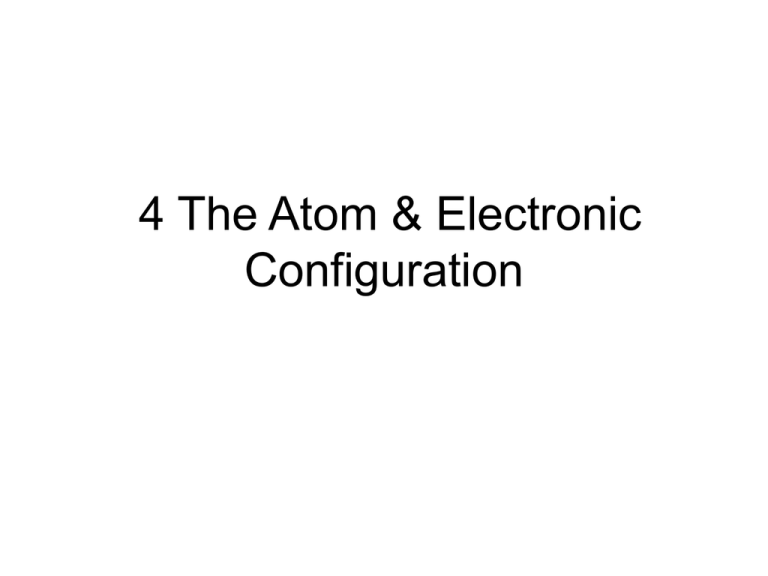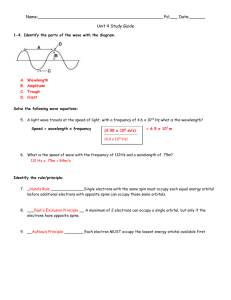The Atom & Electronic Configuration
advertisement

4 The Atom & Electronic Configuration Bohr Model of the Atom Bohr suggested that an electron moving in an orbit can only have certain amounts of energy not an infinite number of value. This energy is quantised. The energy that an electron needs in order to move in a particular orbit depends on the radius of the orbit. An electron in an orbit further away from the nucleus requires higher energy than an electron nearer the nucleus. If the energy of the electron is quantised then the radius of the orbit must also be quantised. there are a restricted number of orbits. Ionisation Energy Definition The 1st ionisation energy of an element is the energy change for the conversion of 1mol of gaseous atoms into 1 mol of gaseous ions i.e the energy change for the process M(g) M+(g) + e Similarly the 2nd ionisation energy is the energy change for the process M+(g) M2+(g) + e e.g. 1st ionisation energy 2nd ionisation energy H = 1310 KJ/mol He = 2370 KJ/mol 5250 KJ/mol The second electron is always harder to remove than the 1st x 2p x Helium contains 2 electrons and 2 protons. When 1 electron is removed there are still 2 positive charges in the nucleus more attraction on the remaining electron which then requires more energy to remove. Lithium has 3 electrons and 3 protons 1st I.E. = 519 KJ/mol 2nd I.E. = 7300 Kj/mol 3rd I.E. = 11800 Kj/mol Notice the large increase in ionisation energy between the 1st and 2nd and then a smaller jump between the 2nd and 3rd x x 3p x The outer electron is easier to remove as it is in a shell further away from the nucleus Carbon has 6 electrons 2 in first shell. 4 in second shell and 6 protons in the nucleus (electronic configuration 2,4) x x x 6p x x x The 4 electrons in the second shell are easier to remove than the 2 in the first shell as they are further from the nucleus. However if we plot a graph of ionisation energy against electron removed 14000 12000 1 Line 2 Line 3 Line 4 Line 5 Line 6 Line 7 10000 8000 6000 4000 2000 0 1, 2 3 4 The first 2 electrons are relatively easy to remove, the 2nd two slightly harder and the last 2 much harder. The first 4 are in the outer shell the last 2 are in the inner shell Notice the ease of removal is not a smooth trend from 1 4 . There is a slight jump in ionisation energy between the 2nd and 3rd electron. This suggests that the 1& 2 electrons being removed are in a slightly lower energy level than the 3 & 4 5 6 From this we conclude that the 2nd shell consists of 2 subshells, one slightly closer to the nucleus than the other 1s 2s x x x 6p x x x 2p We now write the electronic configuration as 1s2 2s2 2p2 The first 2 electrons (1,2) removed are in a 2p orbital The next 2 electrons (3,4) removed are in 2s orbital The last 2 electrons (5,6) removed are in a 1s orbital There is also a third type of orbital called a d orbital. The first element with a d orbital is scandium (the first transition element) ALL orbitals can hold 2 electrons. The first shell has only 1 s orbital The second shell has 1 s orbital and 3 p orbitals The 3rd shell has 1 s orbital, 3 p orbitals and 5 d orbitals The first shell can hold 2 electrons The second shell can hold 8 electrons The third shell can hold 18 electrons We can now write electronic configurations as follows Li 3electrons 1s2 2s1 C 6 electrons 1s2 2s2 2p2 Na 11 electrons 1s2 2s2 2p6 3s1 Note that the outer shell contains the same no of electrons as the group number. Carbon group 4 has 4 electrons in the 2nd shell Finding the electronic configuration of ions Li 1s2 2s1 Li+ 1s 2 It has lost 1 electron and now has a filled shell and is stable Be 1s2 2s2 Be2+ 1s2 it has lost 2 electrons and and now has a filled shell and is stable Write the configuration of the following elements N Mg Al Cl 1s22s22p3 1s22s22p63s2 1s22s22p63s23p1 Al3+ F- Na+ 1s22s22p6 1s22s22p6 1s22s22p6 1s22s22p63s23p5 Elements in groups 1 and 2 are filling s orbitals and are called s block Element in groups 2-8 are filling p orbitals and are called p block The transition elements are filling d orbitals and are called d block When we write a configuration we ‘fill’ orbitals from the lowest energy to the highest. i.e. electrons are added to the inner 1s orbital first followed by 2s then 2p etc. This is called the aufbau principal (to build up) An atom with all electrons in the lowest possible energy levels is said to be in its ground state When writing configurations for the transition elements the 4s orbital is filled before the 3d (the 4s orbital is actually lower in energy than the 3d) So the configuration of Sc is 1s22s22p63s23p64s23d1 It is the first transition metals and has 1 d electron. (It is easy to find the number of d electrons – just count from scandium across the row)




